Organisational Behaviour Management
VerifiedAdded on 2021/01/02
|15
|4895
|421
AI Summary
Contribute Materials
Your contribution can guide someone’s learning journey. Share your
documents today.
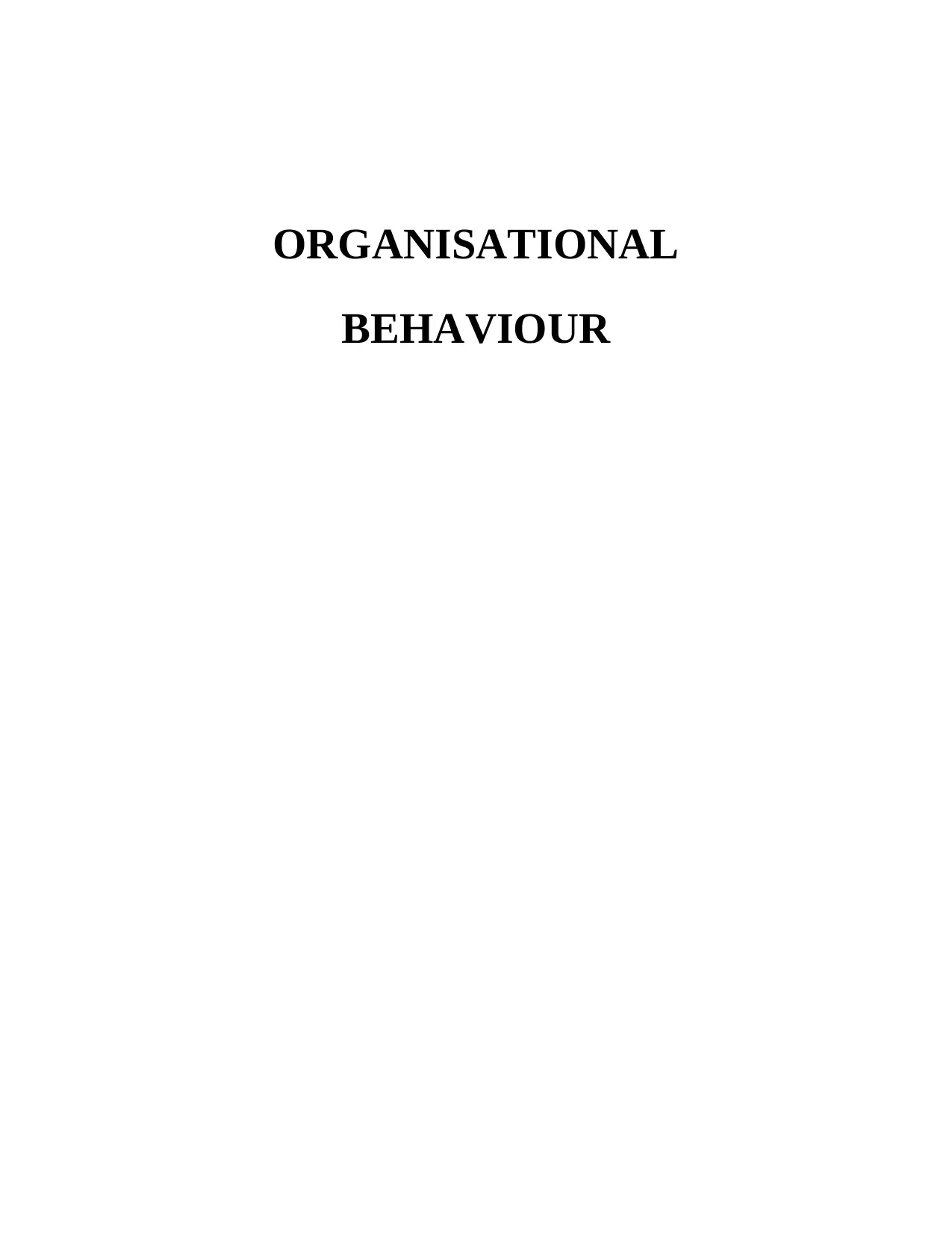
ORGANISATIONAL
BEHAVIOUR
BEHAVIOUR
Secure Best Marks with AI Grader
Need help grading? Try our AI Grader for instant feedback on your assignments.
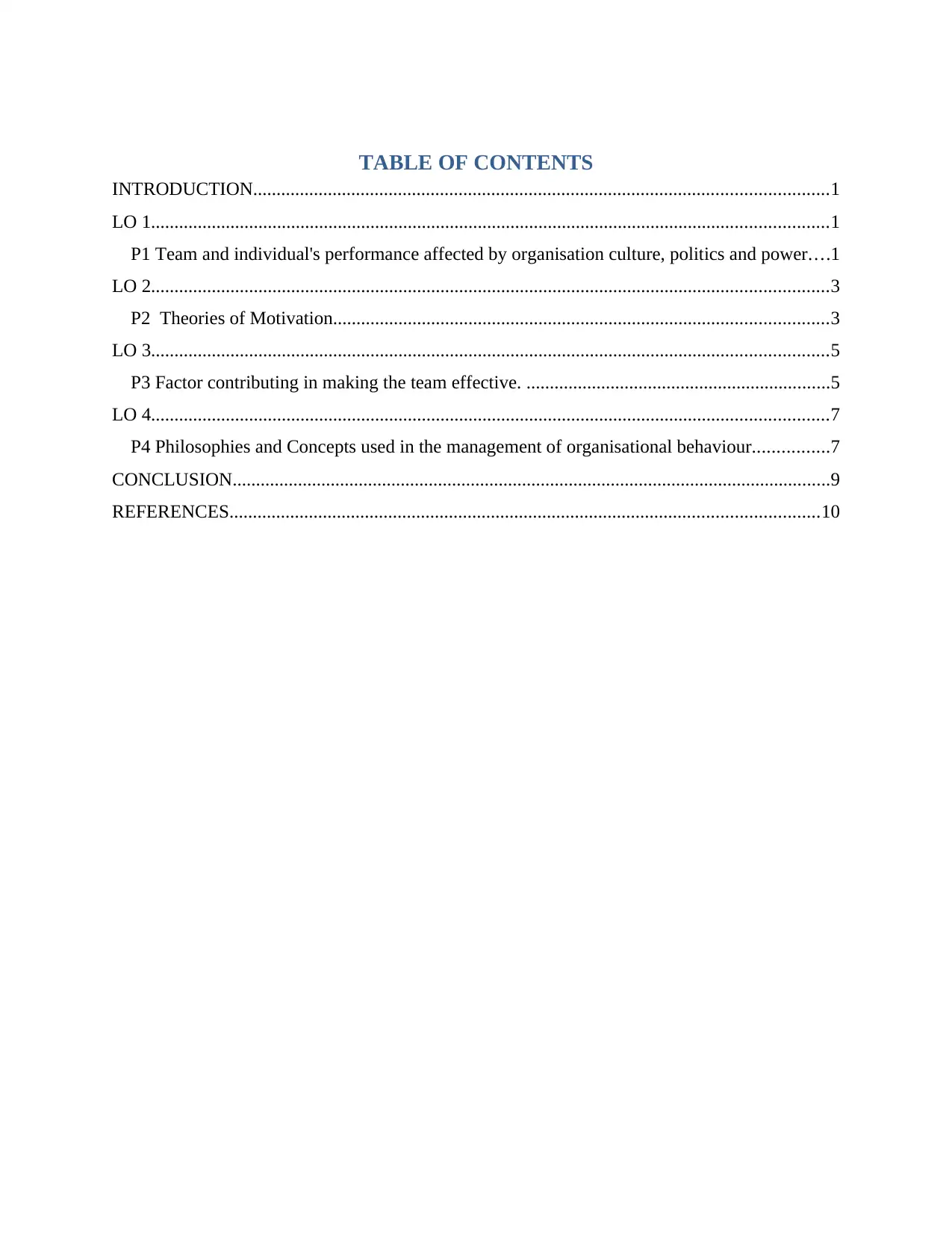
TABLE OF CONTENTS
INTRODUCTION...........................................................................................................................1
LO 1.................................................................................................................................................1
P1 Team and individual's performance affected by organisation culture, politics and power....1
LO 2.................................................................................................................................................3
P2 Theories of Motivation..........................................................................................................3
LO 3.................................................................................................................................................5
P3 Factor contributing in making the team effective. .................................................................5
LO 4.................................................................................................................................................7
P4 Philosophies and Concepts used in the management of organisational behaviour................7
CONCLUSION................................................................................................................................9
REFERENCES..............................................................................................................................10
INTRODUCTION...........................................................................................................................1
LO 1.................................................................................................................................................1
P1 Team and individual's performance affected by organisation culture, politics and power....1
LO 2.................................................................................................................................................3
P2 Theories of Motivation..........................................................................................................3
LO 3.................................................................................................................................................5
P3 Factor contributing in making the team effective. .................................................................5
LO 4.................................................................................................................................................7
P4 Philosophies and Concepts used in the management of organisational behaviour................7
CONCLUSION................................................................................................................................9
REFERENCES..............................................................................................................................10
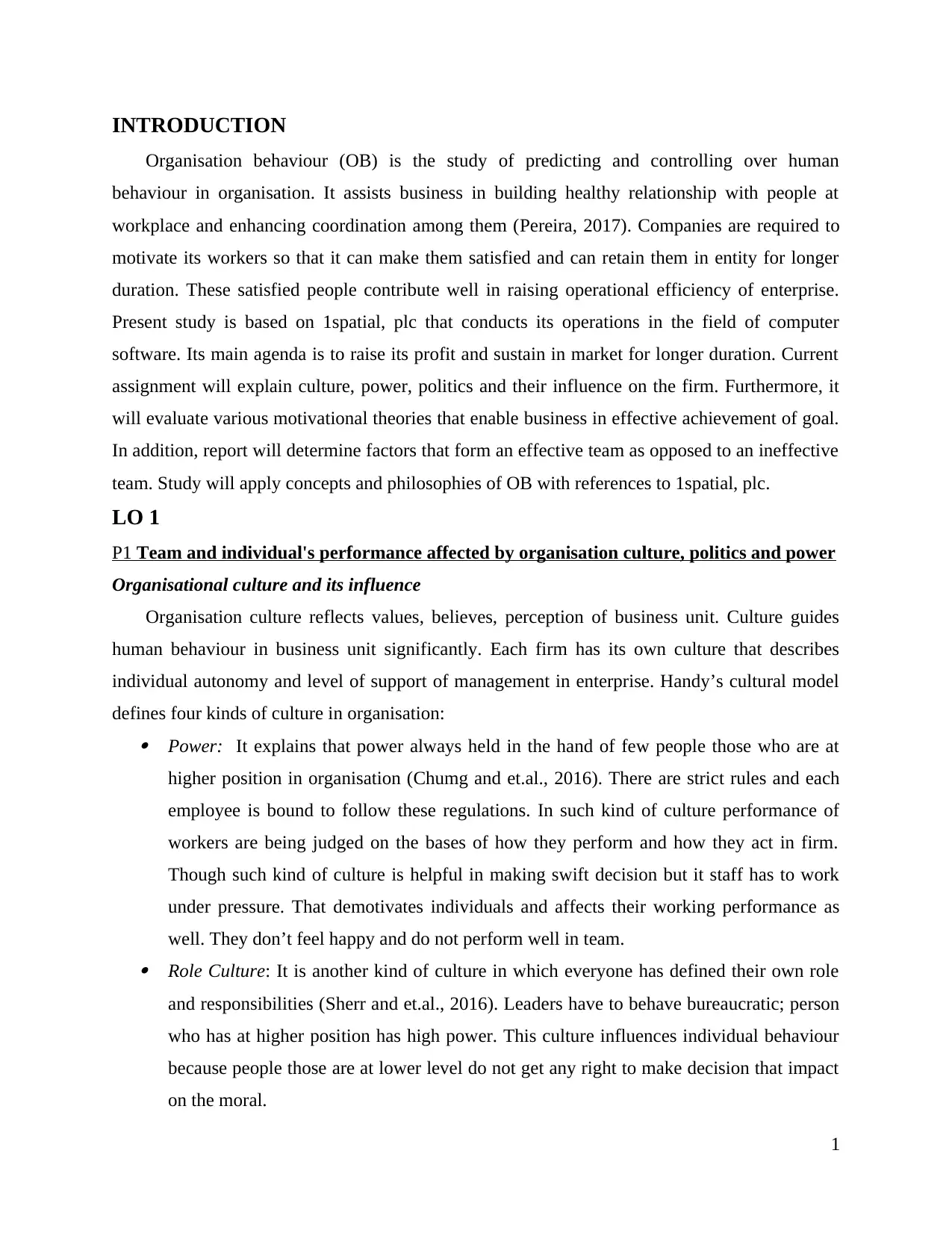
INTRODUCTION
Organisation behaviour (OB) is the study of predicting and controlling over human
behaviour in organisation. It assists business in building healthy relationship with people at
workplace and enhancing coordination among them (Pereira, 2017). Companies are required to
motivate its workers so that it can make them satisfied and can retain them in entity for longer
duration. These satisfied people contribute well in raising operational efficiency of enterprise.
Present study is based on 1spatial, plc that conducts its operations in the field of computer
software. Its main agenda is to raise its profit and sustain in market for longer duration. Current
assignment will explain culture, power, politics and their influence on the firm. Furthermore, it
will evaluate various motivational theories that enable business in effective achievement of goal.
In addition, report will determine factors that form an effective team as opposed to an ineffective
team. Study will apply concepts and philosophies of OB with references to 1spatial, plc.
LO 1
P1 Team and individual's performance affected by organisation culture, politics and power
Organisational culture and its influence
Organisation culture reflects values, believes, perception of business unit. Culture guides
human behaviour in business unit significantly. Each firm has its own culture that describes
individual autonomy and level of support of management in enterprise. Handy’s cultural model
defines four kinds of culture in organisation: Power: It explains that power always held in the hand of few people those who are at
higher position in organisation (Chumg and et.al., 2016). There are strict rules and each
employee is bound to follow these regulations. In such kind of culture performance of
workers are being judged on the bases of how they perform and how they act in firm.
Though such kind of culture is helpful in making swift decision but it staff has to work
under pressure. That demotivates individuals and affects their working performance as
well. They don’t feel happy and do not perform well in team. Role Culture: It is another kind of culture in which everyone has defined their own role
and responsibilities (Sherr and et.al., 2016). Leaders have to behave bureaucratic; person
who has at higher position has high power. This culture influences individual behaviour
because people those are at lower level do not get any right to make decision that impact
on the moral.
1
Organisation behaviour (OB) is the study of predicting and controlling over human
behaviour in organisation. It assists business in building healthy relationship with people at
workplace and enhancing coordination among them (Pereira, 2017). Companies are required to
motivate its workers so that it can make them satisfied and can retain them in entity for longer
duration. These satisfied people contribute well in raising operational efficiency of enterprise.
Present study is based on 1spatial, plc that conducts its operations in the field of computer
software. Its main agenda is to raise its profit and sustain in market for longer duration. Current
assignment will explain culture, power, politics and their influence on the firm. Furthermore, it
will evaluate various motivational theories that enable business in effective achievement of goal.
In addition, report will determine factors that form an effective team as opposed to an ineffective
team. Study will apply concepts and philosophies of OB with references to 1spatial, plc.
LO 1
P1 Team and individual's performance affected by organisation culture, politics and power
Organisational culture and its influence
Organisation culture reflects values, believes, perception of business unit. Culture guides
human behaviour in business unit significantly. Each firm has its own culture that describes
individual autonomy and level of support of management in enterprise. Handy’s cultural model
defines four kinds of culture in organisation: Power: It explains that power always held in the hand of few people those who are at
higher position in organisation (Chumg and et.al., 2016). There are strict rules and each
employee is bound to follow these regulations. In such kind of culture performance of
workers are being judged on the bases of how they perform and how they act in firm.
Though such kind of culture is helpful in making swift decision but it staff has to work
under pressure. That demotivates individuals and affects their working performance as
well. They don’t feel happy and do not perform well in team. Role Culture: It is another kind of culture in which everyone has defined their own role
and responsibilities (Sherr and et.al., 2016). Leaders have to behave bureaucratic; person
who has at higher position has high power. This culture influences individual behaviour
because people those are at lower level do not get any right to make decision that impact
on the moral.
1
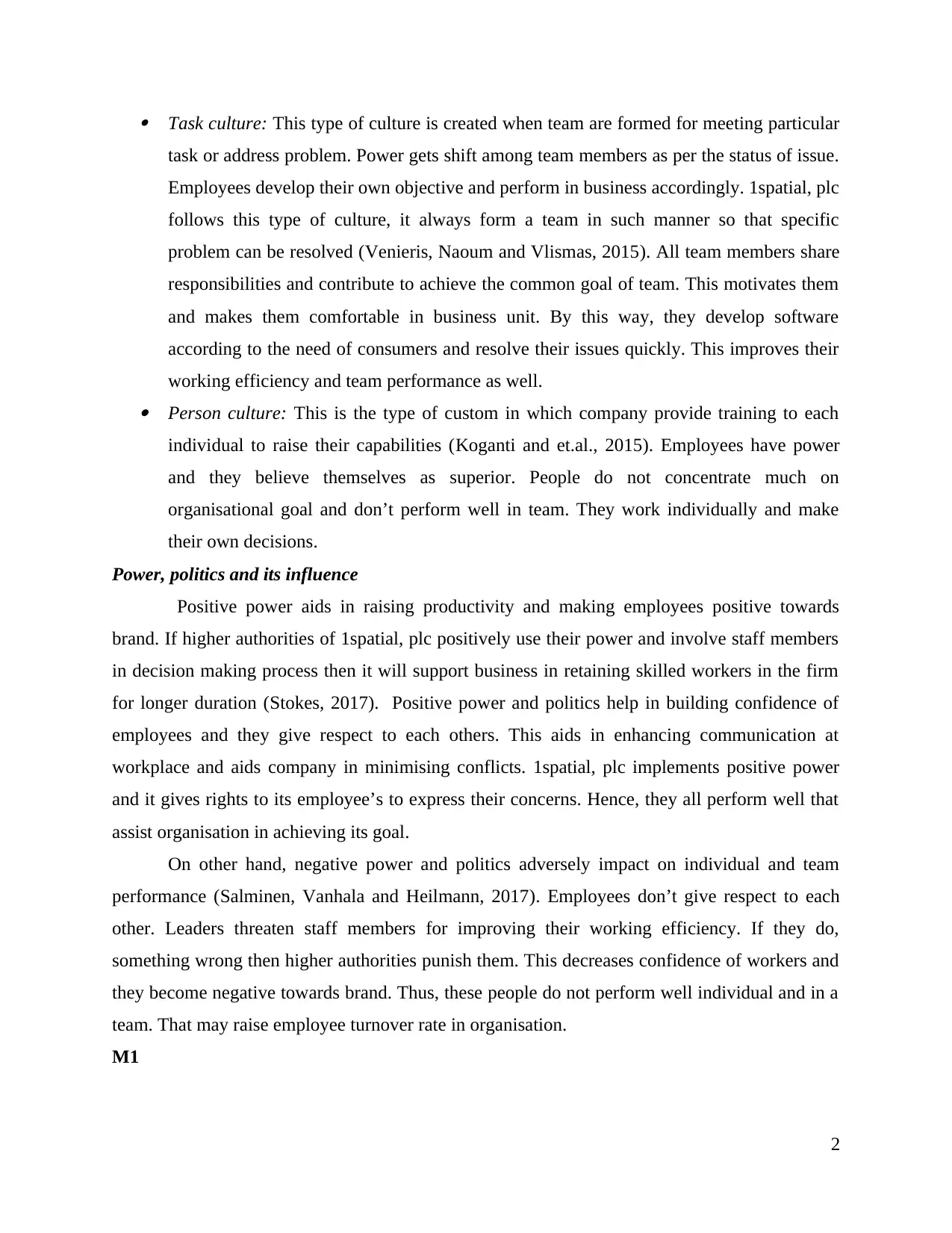
Task culture: This type of culture is created when team are formed for meeting particular
task or address problem. Power gets shift among team members as per the status of issue.
Employees develop their own objective and perform in business accordingly. 1spatial, plc
follows this type of culture, it always form a team in such manner so that specific
problem can be resolved (Venieris, Naoum and Vlismas, 2015). All team members share
responsibilities and contribute to achieve the common goal of team. This motivates them
and makes them comfortable in business unit. By this way, they develop software
according to the need of consumers and resolve their issues quickly. This improves their
working efficiency and team performance as well. Person culture: This is the type of custom in which company provide training to each
individual to raise their capabilities (Koganti and et.al., 2015). Employees have power
and they believe themselves as superior. People do not concentrate much on
organisational goal and don’t perform well in team. They work individually and make
their own decisions.
Power, politics and its influence
Positive power aids in raising productivity and making employees positive towards
brand. If higher authorities of 1spatial, plc positively use their power and involve staff members
in decision making process then it will support business in retaining skilled workers in the firm
for longer duration (Stokes, 2017). Positive power and politics help in building confidence of
employees and they give respect to each others. This aids in enhancing communication at
workplace and aids company in minimising conflicts. 1spatial, plc implements positive power
and it gives rights to its employee’s to express their concerns. Hence, they all perform well that
assist organisation in achieving its goal.
On other hand, negative power and politics adversely impact on individual and team
performance (Salminen, Vanhala and Heilmann, 2017). Employees don’t give respect to each
other. Leaders threaten staff members for improving their working efficiency. If they do,
something wrong then higher authorities punish them. This decreases confidence of workers and
they become negative towards brand. Thus, these people do not perform well individual and in a
team. That may raise employee turnover rate in organisation.
M1
2
task or address problem. Power gets shift among team members as per the status of issue.
Employees develop their own objective and perform in business accordingly. 1spatial, plc
follows this type of culture, it always form a team in such manner so that specific
problem can be resolved (Venieris, Naoum and Vlismas, 2015). All team members share
responsibilities and contribute to achieve the common goal of team. This motivates them
and makes them comfortable in business unit. By this way, they develop software
according to the need of consumers and resolve their issues quickly. This improves their
working efficiency and team performance as well. Person culture: This is the type of custom in which company provide training to each
individual to raise their capabilities (Koganti and et.al., 2015). Employees have power
and they believe themselves as superior. People do not concentrate much on
organisational goal and don’t perform well in team. They work individually and make
their own decisions.
Power, politics and its influence
Positive power aids in raising productivity and making employees positive towards
brand. If higher authorities of 1spatial, plc positively use their power and involve staff members
in decision making process then it will support business in retaining skilled workers in the firm
for longer duration (Stokes, 2017). Positive power and politics help in building confidence of
employees and they give respect to each others. This aids in enhancing communication at
workplace and aids company in minimising conflicts. 1spatial, plc implements positive power
and it gives rights to its employee’s to express their concerns. Hence, they all perform well that
assist organisation in achieving its goal.
On other hand, negative power and politics adversely impact on individual and team
performance (Salminen, Vanhala and Heilmann, 2017). Employees don’t give respect to each
other. Leaders threaten staff members for improving their working efficiency. If they do,
something wrong then higher authorities punish them. This decreases confidence of workers and
they become negative towards brand. Thus, these people do not perform well individual and in a
team. That may raise employee turnover rate in organisation.
M1
2
Secure Best Marks with AI Grader
Need help grading? Try our AI Grader for instant feedback on your assignments.
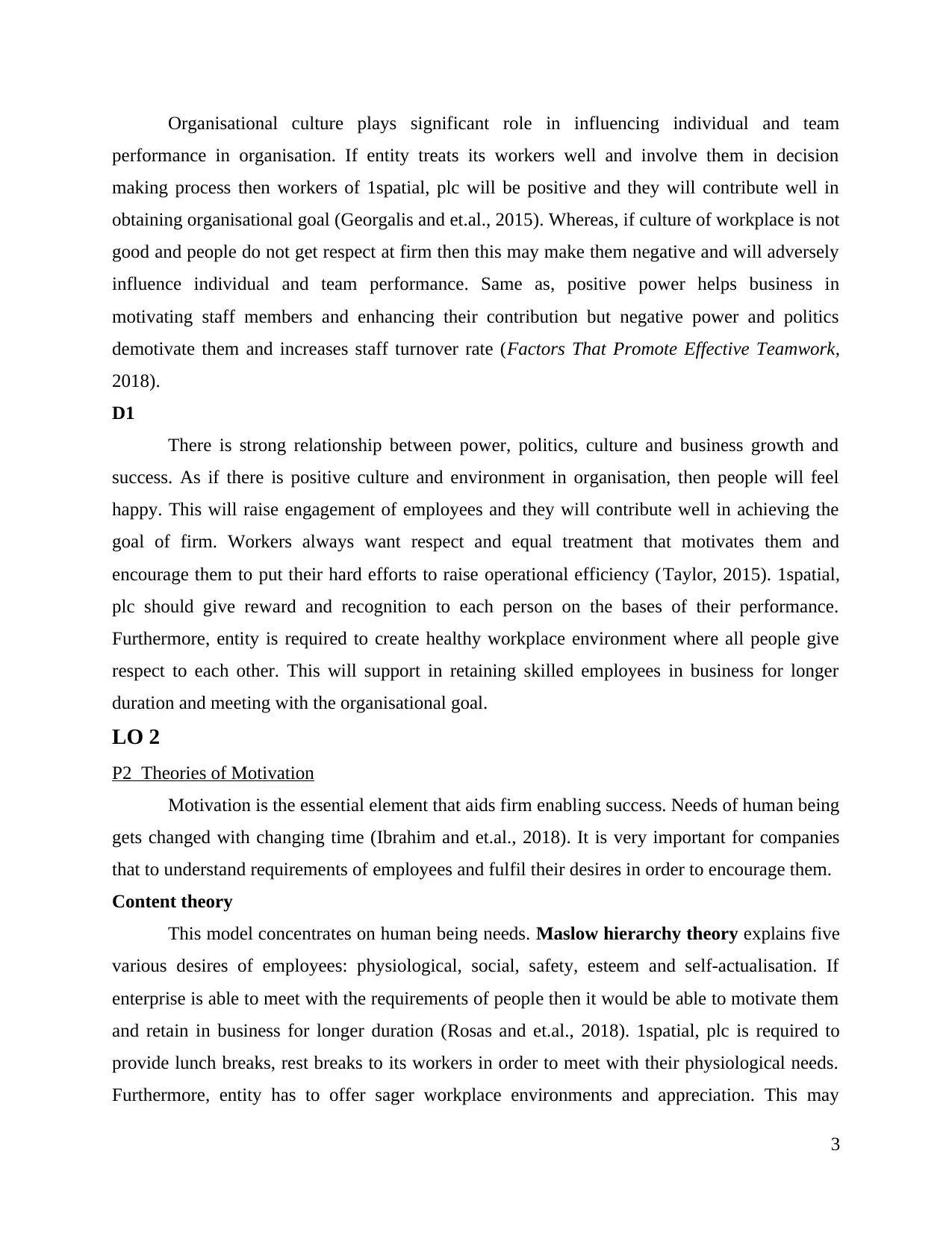
Organisational culture plays significant role in influencing individual and team
performance in organisation. If entity treats its workers well and involve them in decision
making process then workers of 1spatial, plc will be positive and they will contribute well in
obtaining organisational goal (Georgalis and et.al., 2015). Whereas, if culture of workplace is not
good and people do not get respect at firm then this may make them negative and will adversely
influence individual and team performance. Same as, positive power helps business in
motivating staff members and enhancing their contribution but negative power and politics
demotivate them and increases staff turnover rate (Factors That Promote Effective Teamwork,
2018).
D1
There is strong relationship between power, politics, culture and business growth and
success. As if there is positive culture and environment in organisation, then people will feel
happy. This will raise engagement of employees and they will contribute well in achieving the
goal of firm. Workers always want respect and equal treatment that motivates them and
encourage them to put their hard efforts to raise operational efficiency (Taylor, 2015). 1spatial,
plc should give reward and recognition to each person on the bases of their performance.
Furthermore, entity is required to create healthy workplace environment where all people give
respect to each other. This will support in retaining skilled employees in business for longer
duration and meeting with the organisational goal.
LO 2
P2 Theories of Motivation
Motivation is the essential element that aids firm enabling success. Needs of human being
gets changed with changing time (Ibrahim and et.al., 2018). It is very important for companies
that to understand requirements of employees and fulfil their desires in order to encourage them.
Content theory
This model concentrates on human being needs. Maslow hierarchy theory explains five
various desires of employees: physiological, social, safety, esteem and self-actualisation. If
enterprise is able to meet with the requirements of people then it would be able to motivate them
and retain in business for longer duration (Rosas and et.al., 2018). 1spatial, plc is required to
provide lunch breaks, rest breaks to its workers in order to meet with their physiological needs.
Furthermore, entity has to offer sager workplace environments and appreciation. This may
3
performance in organisation. If entity treats its workers well and involve them in decision
making process then workers of 1spatial, plc will be positive and they will contribute well in
obtaining organisational goal (Georgalis and et.al., 2015). Whereas, if culture of workplace is not
good and people do not get respect at firm then this may make them negative and will adversely
influence individual and team performance. Same as, positive power helps business in
motivating staff members and enhancing their contribution but negative power and politics
demotivate them and increases staff turnover rate (Factors That Promote Effective Teamwork,
2018).
D1
There is strong relationship between power, politics, culture and business growth and
success. As if there is positive culture and environment in organisation, then people will feel
happy. This will raise engagement of employees and they will contribute well in achieving the
goal of firm. Workers always want respect and equal treatment that motivates them and
encourage them to put their hard efforts to raise operational efficiency (Taylor, 2015). 1spatial,
plc should give reward and recognition to each person on the bases of their performance.
Furthermore, entity is required to create healthy workplace environment where all people give
respect to each other. This will support in retaining skilled employees in business for longer
duration and meeting with the organisational goal.
LO 2
P2 Theories of Motivation
Motivation is the essential element that aids firm enabling success. Needs of human being
gets changed with changing time (Ibrahim and et.al., 2018). It is very important for companies
that to understand requirements of employees and fulfil their desires in order to encourage them.
Content theory
This model concentrates on human being needs. Maslow hierarchy theory explains five
various desires of employees: physiological, social, safety, esteem and self-actualisation. If
enterprise is able to meet with the requirements of people then it would be able to motivate them
and retain in business for longer duration (Rosas and et.al., 2018). 1spatial, plc is required to
provide lunch breaks, rest breaks to its workers in order to meet with their physiological needs.
Furthermore, entity has to offer sager workplace environments and appreciation. This may
3
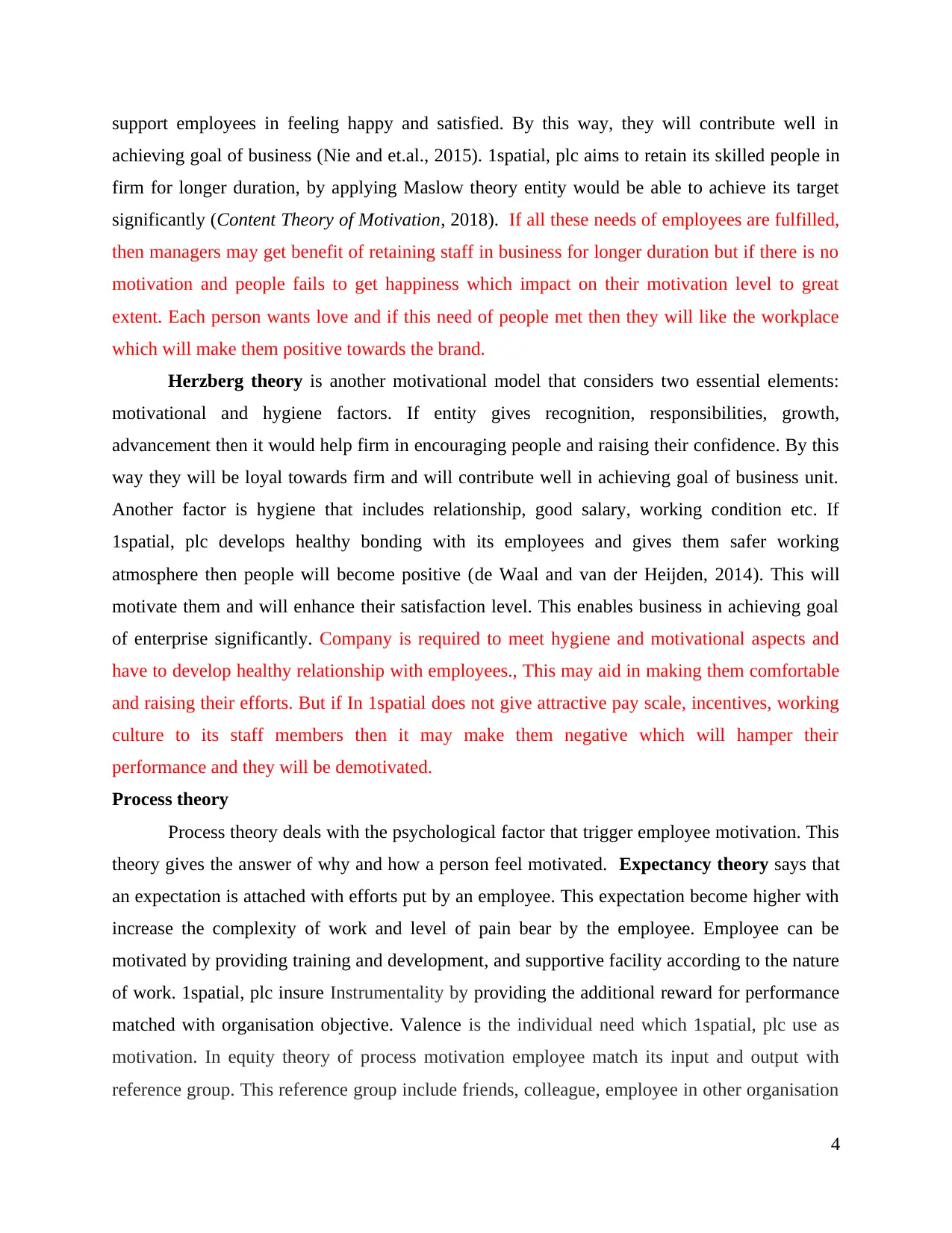
support employees in feeling happy and satisfied. By this way, they will contribute well in
achieving goal of business (Nie and et.al., 2015). 1spatial, plc aims to retain its skilled people in
firm for longer duration, by applying Maslow theory entity would be able to achieve its target
significantly (Content Theory of Motivation, 2018). If all these needs of employees are fulfilled,
then managers may get benefit of retaining staff in business for longer duration but if there is no
motivation and people fails to get happiness which impact on their motivation level to great
extent. Each person wants love and if this need of people met then they will like the workplace
which will make them positive towards the brand.
Herzberg theory is another motivational model that considers two essential elements:
motivational and hygiene factors. If entity gives recognition, responsibilities, growth,
advancement then it would help firm in encouraging people and raising their confidence. By this
way they will be loyal towards firm and will contribute well in achieving goal of business unit.
Another factor is hygiene that includes relationship, good salary, working condition etc. If
1spatial, plc develops healthy bonding with its employees and gives them safer working
atmosphere then people will become positive (de Waal and van der Heijden, 2014). This will
motivate them and will enhance their satisfaction level. This enables business in achieving goal
of enterprise significantly. Company is required to meet hygiene and motivational aspects and
have to develop healthy relationship with employees., This may aid in making them comfortable
and raising their efforts. But if In 1spatial does not give attractive pay scale, incentives, working
culture to its staff members then it may make them negative which will hamper their
performance and they will be demotivated.
Process theory
Process theory deals with the psychological factor that trigger employee motivation. This
theory gives the answer of why and how a person feel motivated. Expectancy theory says that
an expectation is attached with efforts put by an employee. This expectation become higher with
increase the complexity of work and level of pain bear by the employee. Employee can be
motivated by providing training and development, and supportive facility according to the nature
of work. 1spatial, plc insure Instrumentality by providing the additional reward for performance
matched with organisation objective. Valence is the individual need which 1spatial, plc use as
motivation. In equity theory of process motivation employee match its input and output with
reference group. This reference group include friends, colleague, employee in other organisation
4
achieving goal of business (Nie and et.al., 2015). 1spatial, plc aims to retain its skilled people in
firm for longer duration, by applying Maslow theory entity would be able to achieve its target
significantly (Content Theory of Motivation, 2018). If all these needs of employees are fulfilled,
then managers may get benefit of retaining staff in business for longer duration but if there is no
motivation and people fails to get happiness which impact on their motivation level to great
extent. Each person wants love and if this need of people met then they will like the workplace
which will make them positive towards the brand.
Herzberg theory is another motivational model that considers two essential elements:
motivational and hygiene factors. If entity gives recognition, responsibilities, growth,
advancement then it would help firm in encouraging people and raising their confidence. By this
way they will be loyal towards firm and will contribute well in achieving goal of business unit.
Another factor is hygiene that includes relationship, good salary, working condition etc. If
1spatial, plc develops healthy bonding with its employees and gives them safer working
atmosphere then people will become positive (de Waal and van der Heijden, 2014). This will
motivate them and will enhance their satisfaction level. This enables business in achieving goal
of enterprise significantly. Company is required to meet hygiene and motivational aspects and
have to develop healthy relationship with employees., This may aid in making them comfortable
and raising their efforts. But if In 1spatial does not give attractive pay scale, incentives, working
culture to its staff members then it may make them negative which will hamper their
performance and they will be demotivated.
Process theory
Process theory deals with the psychological factor that trigger employee motivation. This
theory gives the answer of why and how a person feel motivated. Expectancy theory says that
an expectation is attached with efforts put by an employee. This expectation become higher with
increase the complexity of work and level of pain bear by the employee. Employee can be
motivated by providing training and development, and supportive facility according to the nature
of work. 1spatial, plc insure Instrumentality by providing the additional reward for performance
matched with organisation objective. Valence is the individual need which 1spatial, plc use as
motivation. In equity theory of process motivation employee match its input and output with
reference group. This reference group include friends, colleague, employee in other organisation
4
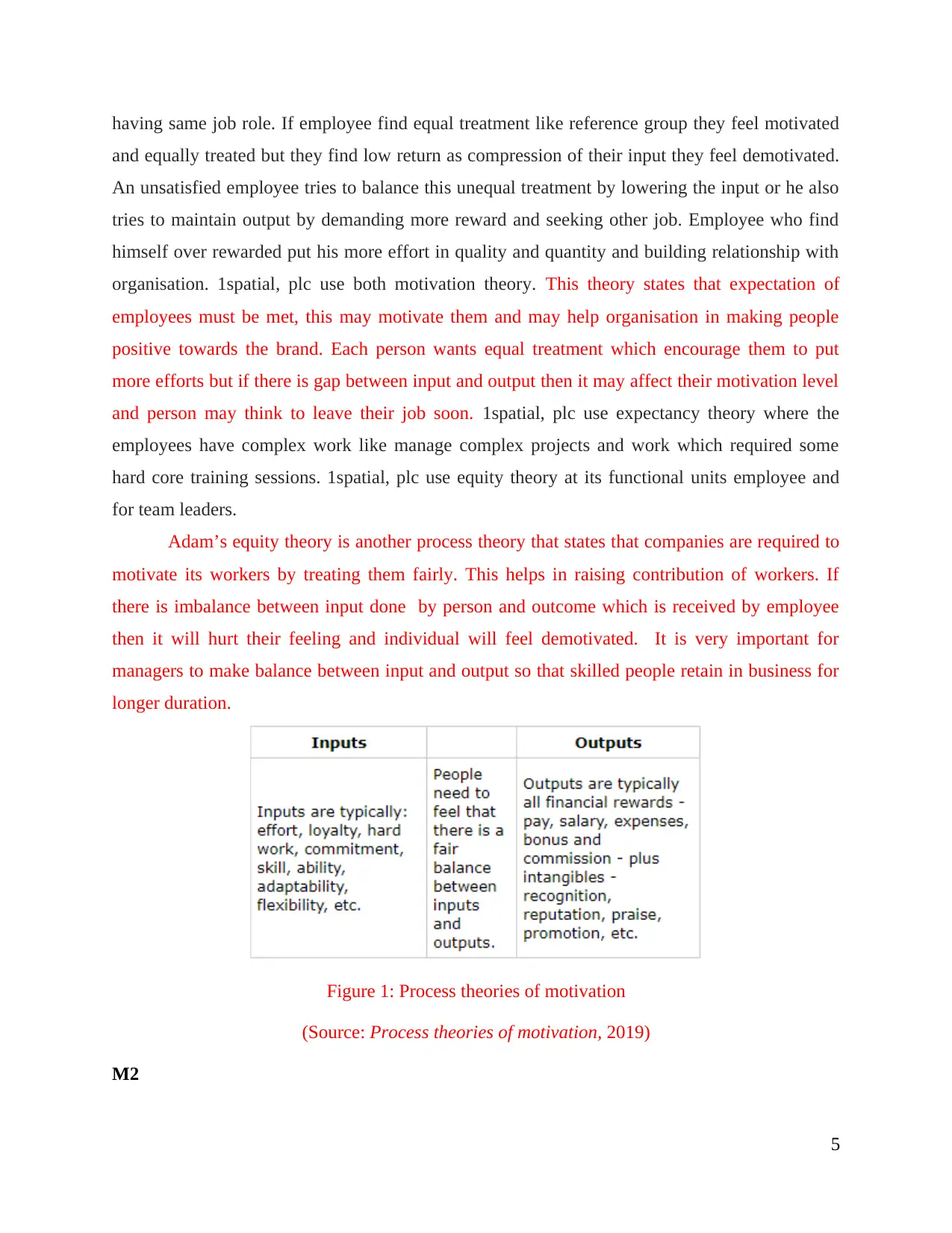
having same job role. If employee find equal treatment like reference group they feel motivated
and equally treated but they find low return as compression of their input they feel demotivated.
An unsatisfied employee tries to balance this unequal treatment by lowering the input or he also
tries to maintain output by demanding more reward and seeking other job. Employee who find
himself over rewarded put his more effort in quality and quantity and building relationship with
organisation. 1spatial, plc use both motivation theory. This theory states that expectation of
employees must be met, this may motivate them and may help organisation in making people
positive towards the brand. Each person wants equal treatment which encourage them to put
more efforts but if there is gap between input and output then it may affect their motivation level
and person may think to leave their job soon. 1spatial, plc use expectancy theory where the
employees have complex work like manage complex projects and work which required some
hard core training sessions. 1spatial, plc use equity theory at its functional units employee and
for team leaders.
Adam’s equity theory is another process theory that states that companies are required to
motivate its workers by treating them fairly. This helps in raising contribution of workers. If
there is imbalance between input done by person and outcome which is received by employee
then it will hurt their feeling and individual will feel demotivated. It is very important for
managers to make balance between input and output so that skilled people retain in business for
longer duration.
Figure 1: Process theories of motivation
(Source: Process theories of motivation, 2019)
M2
5
and equally treated but they find low return as compression of their input they feel demotivated.
An unsatisfied employee tries to balance this unequal treatment by lowering the input or he also
tries to maintain output by demanding more reward and seeking other job. Employee who find
himself over rewarded put his more effort in quality and quantity and building relationship with
organisation. 1spatial, plc use both motivation theory. This theory states that expectation of
employees must be met, this may motivate them and may help organisation in making people
positive towards the brand. Each person wants equal treatment which encourage them to put
more efforts but if there is gap between input and output then it may affect their motivation level
and person may think to leave their job soon. 1spatial, plc use expectancy theory where the
employees have complex work like manage complex projects and work which required some
hard core training sessions. 1spatial, plc use equity theory at its functional units employee and
for team leaders.
Adam’s equity theory is another process theory that states that companies are required to
motivate its workers by treating them fairly. This helps in raising contribution of workers. If
there is imbalance between input done by person and outcome which is received by employee
then it will hurt their feeling and individual will feel demotivated. It is very important for
managers to make balance between input and output so that skilled people retain in business for
longer duration.
Figure 1: Process theories of motivation
(Source: Process theories of motivation, 2019)
M2
5
Paraphrase This Document
Need a fresh take? Get an instant paraphrase of this document with our AI Paraphraser
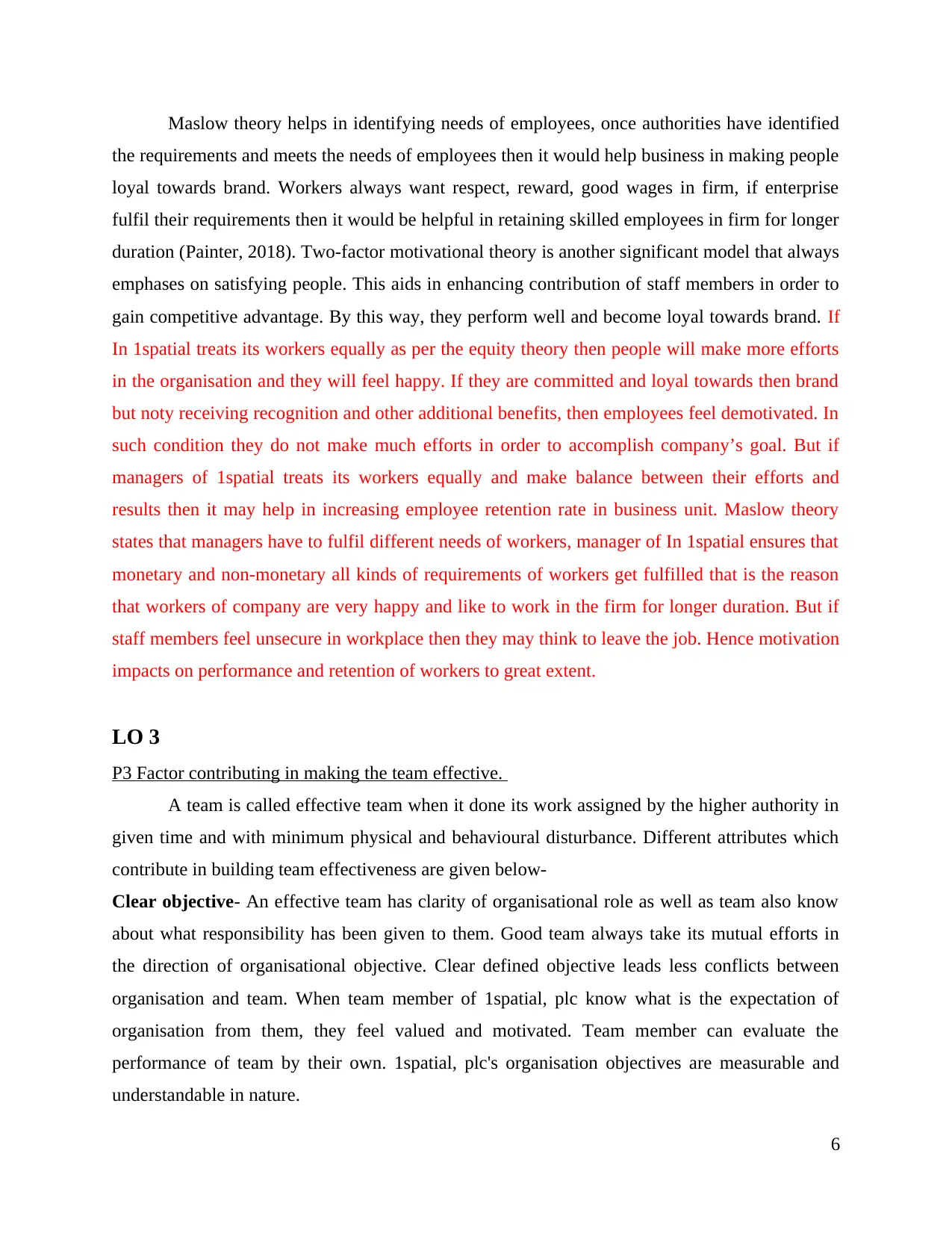
Maslow theory helps in identifying needs of employees, once authorities have identified
the requirements and meets the needs of employees then it would help business in making people
loyal towards brand. Workers always want respect, reward, good wages in firm, if enterprise
fulfil their requirements then it would be helpful in retaining skilled employees in firm for longer
duration (Painter, 2018). Two-factor motivational theory is another significant model that always
emphases on satisfying people. This aids in enhancing contribution of staff members in order to
gain competitive advantage. By this way, they perform well and become loyal towards brand. If
In 1spatial treats its workers equally as per the equity theory then people will make more efforts
in the organisation and they will feel happy. If they are committed and loyal towards then brand
but noty receiving recognition and other additional benefits, then employees feel demotivated. In
such condition they do not make much efforts in order to accomplish company’s goal. But if
managers of 1spatial treats its workers equally and make balance between their efforts and
results then it may help in increasing employee retention rate in business unit. Maslow theory
states that managers have to fulfil different needs of workers, manager of In 1spatial ensures that
monetary and non-monetary all kinds of requirements of workers get fulfilled that is the reason
that workers of company are very happy and like to work in the firm for longer duration. But if
staff members feel unsecure in workplace then they may think to leave the job. Hence motivation
impacts on performance and retention of workers to great extent.
LO 3
P3 Factor contributing in making the team effective.
A team is called effective team when it done its work assigned by the higher authority in
given time and with minimum physical and behavioural disturbance. Different attributes which
contribute in building team effectiveness are given below-
Clear objective- An effective team has clarity of organisational role as well as team also know
about what responsibility has been given to them. Good team always take its mutual efforts in
the direction of organisational objective. Clear defined objective leads less conflicts between
organisation and team. When team member of 1spatial, plc know what is the expectation of
organisation from them, they feel valued and motivated. Team member can evaluate the
performance of team by their own. 1spatial, plc's organisation objectives are measurable and
understandable in nature.
6
the requirements and meets the needs of employees then it would help business in making people
loyal towards brand. Workers always want respect, reward, good wages in firm, if enterprise
fulfil their requirements then it would be helpful in retaining skilled employees in firm for longer
duration (Painter, 2018). Two-factor motivational theory is another significant model that always
emphases on satisfying people. This aids in enhancing contribution of staff members in order to
gain competitive advantage. By this way, they perform well and become loyal towards brand. If
In 1spatial treats its workers equally as per the equity theory then people will make more efforts
in the organisation and they will feel happy. If they are committed and loyal towards then brand
but noty receiving recognition and other additional benefits, then employees feel demotivated. In
such condition they do not make much efforts in order to accomplish company’s goal. But if
managers of 1spatial treats its workers equally and make balance between their efforts and
results then it may help in increasing employee retention rate in business unit. Maslow theory
states that managers have to fulfil different needs of workers, manager of In 1spatial ensures that
monetary and non-monetary all kinds of requirements of workers get fulfilled that is the reason
that workers of company are very happy and like to work in the firm for longer duration. But if
staff members feel unsecure in workplace then they may think to leave the job. Hence motivation
impacts on performance and retention of workers to great extent.
LO 3
P3 Factor contributing in making the team effective.
A team is called effective team when it done its work assigned by the higher authority in
given time and with minimum physical and behavioural disturbance. Different attributes which
contribute in building team effectiveness are given below-
Clear objective- An effective team has clarity of organisational role as well as team also know
about what responsibility has been given to them. Good team always take its mutual efforts in
the direction of organisational objective. Clear defined objective leads less conflicts between
organisation and team. When team member of 1spatial, plc know what is the expectation of
organisation from them, they feel valued and motivated. Team member can evaluate the
performance of team by their own. 1spatial, plc's organisation objectives are measurable and
understandable in nature.
6
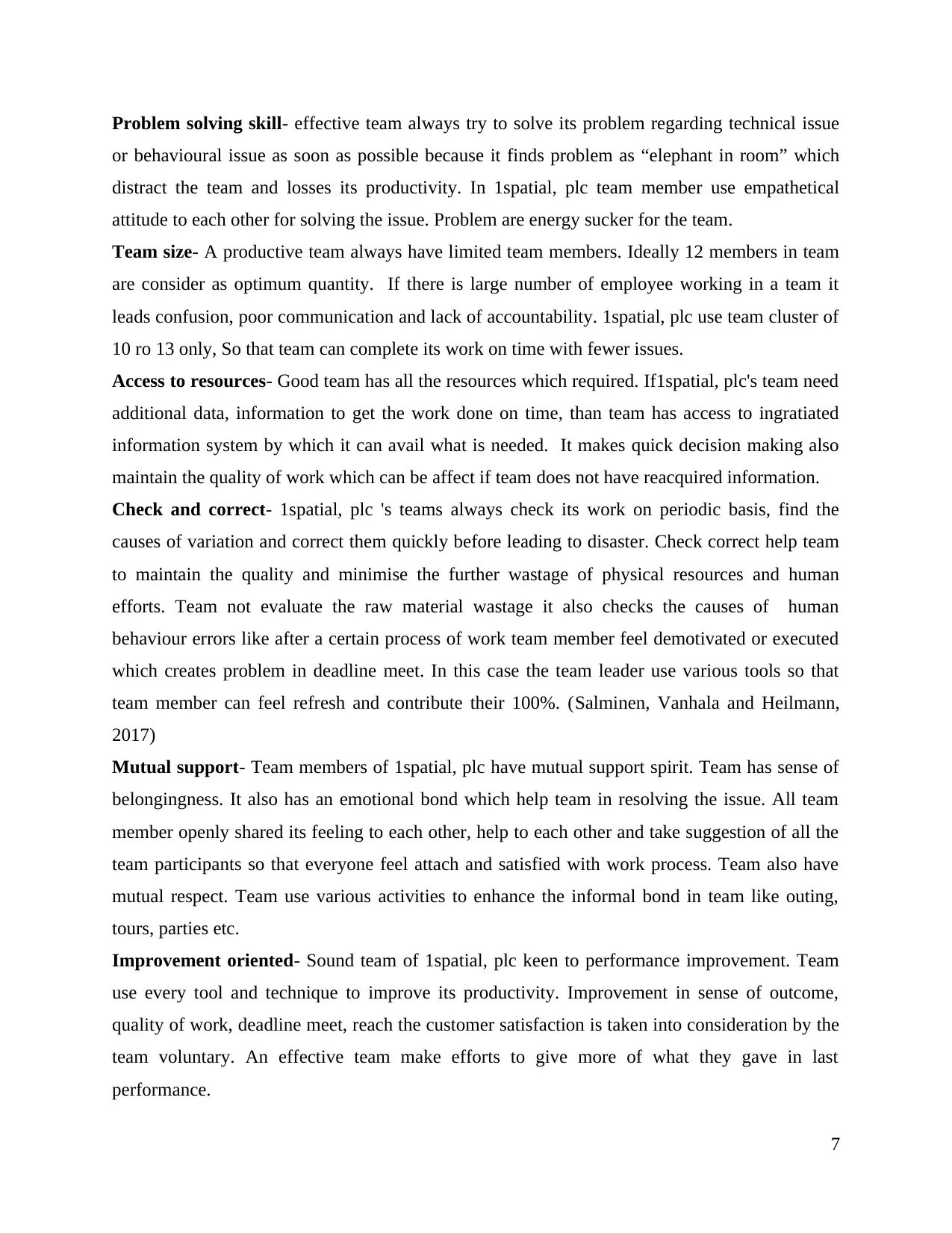
Problem solving skill- effective team always try to solve its problem regarding technical issue
or behavioural issue as soon as possible because it finds problem as “elephant in room” which
distract the team and losses its productivity. In 1spatial, plc team member use empathetical
attitude to each other for solving the issue. Problem are energy sucker for the team.
Team size- A productive team always have limited team members. Ideally 12 members in team
are consider as optimum quantity. If there is large number of employee working in a team it
leads confusion, poor communication and lack of accountability. 1spatial, plc use team cluster of
10 ro 13 only, So that team can complete its work on time with fewer issues.
Access to resources- Good team has all the resources which required. If1spatial, plc's team need
additional data, information to get the work done on time, than team has access to ingratiated
information system by which it can avail what is needed. It makes quick decision making also
maintain the quality of work which can be affect if team does not have reacquired information.
Check and correct- 1spatial, plc 's teams always check its work on periodic basis, find the
causes of variation and correct them quickly before leading to disaster. Check correct help team
to maintain the quality and minimise the further wastage of physical resources and human
efforts. Team not evaluate the raw material wastage it also checks the causes of human
behaviour errors like after a certain process of work team member feel demotivated or executed
which creates problem in deadline meet. In this case the team leader use various tools so that
team member can feel refresh and contribute their 100%. (Salminen, Vanhala and Heilmann,
2017)
Mutual support- Team members of 1spatial, plc have mutual support spirit. Team has sense of
belongingness. It also has an emotional bond which help team in resolving the issue. All team
member openly shared its feeling to each other, help to each other and take suggestion of all the
team participants so that everyone feel attach and satisfied with work process. Team also have
mutual respect. Team use various activities to enhance the informal bond in team like outing,
tours, parties etc.
Improvement oriented- Sound team of 1spatial, plc keen to performance improvement. Team
use every tool and technique to improve its productivity. Improvement in sense of outcome,
quality of work, deadline meet, reach the customer satisfaction is taken into consideration by the
team voluntary. An effective team make efforts to give more of what they gave in last
performance.
7
or behavioural issue as soon as possible because it finds problem as “elephant in room” which
distract the team and losses its productivity. In 1spatial, plc team member use empathetical
attitude to each other for solving the issue. Problem are energy sucker for the team.
Team size- A productive team always have limited team members. Ideally 12 members in team
are consider as optimum quantity. If there is large number of employee working in a team it
leads confusion, poor communication and lack of accountability. 1spatial, plc use team cluster of
10 ro 13 only, So that team can complete its work on time with fewer issues.
Access to resources- Good team has all the resources which required. If1spatial, plc's team need
additional data, information to get the work done on time, than team has access to ingratiated
information system by which it can avail what is needed. It makes quick decision making also
maintain the quality of work which can be affect if team does not have reacquired information.
Check and correct- 1spatial, plc 's teams always check its work on periodic basis, find the
causes of variation and correct them quickly before leading to disaster. Check correct help team
to maintain the quality and minimise the further wastage of physical resources and human
efforts. Team not evaluate the raw material wastage it also checks the causes of human
behaviour errors like after a certain process of work team member feel demotivated or executed
which creates problem in deadline meet. In this case the team leader use various tools so that
team member can feel refresh and contribute their 100%. (Salminen, Vanhala and Heilmann,
2017)
Mutual support- Team members of 1spatial, plc have mutual support spirit. Team has sense of
belongingness. It also has an emotional bond which help team in resolving the issue. All team
member openly shared its feeling to each other, help to each other and take suggestion of all the
team participants so that everyone feel attach and satisfied with work process. Team also have
mutual respect. Team use various activities to enhance the informal bond in team like outing,
tours, parties etc.
Improvement oriented- Sound team of 1spatial, plc keen to performance improvement. Team
use every tool and technique to improve its productivity. Improvement in sense of outcome,
quality of work, deadline meet, reach the customer satisfaction is taken into consideration by the
team voluntary. An effective team make efforts to give more of what they gave in last
performance.
7
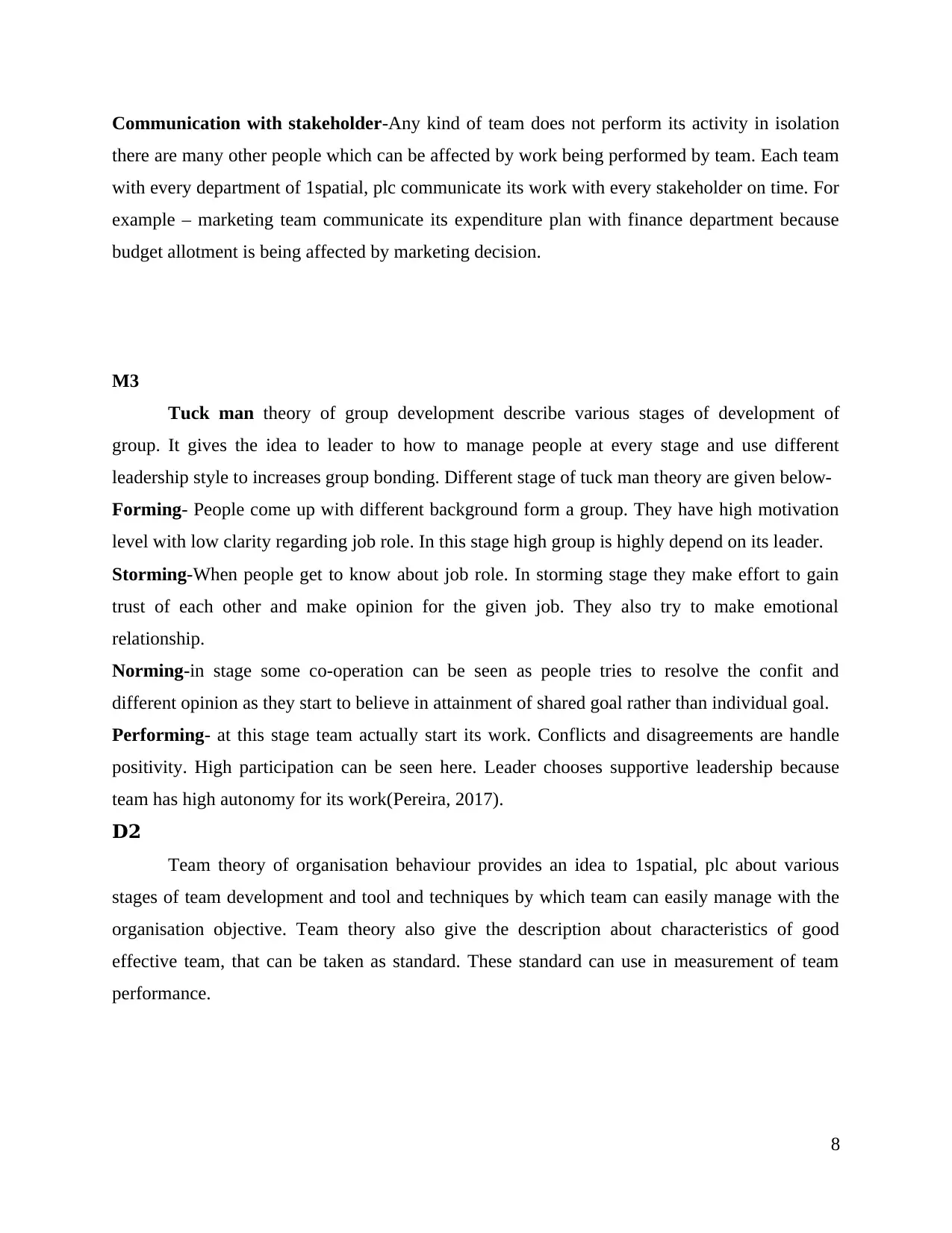
Communication with stakeholder-Any kind of team does not perform its activity in isolation
there are many other people which can be affected by work being performed by team. Each team
with every department of 1spatial, plc communicate its work with every stakeholder on time. For
example – marketing team communicate its expenditure plan with finance department because
budget allotment is being affected by marketing decision.
M3
Tuck man theory of group development describe various stages of development of
group. It gives the idea to leader to how to manage people at every stage and use different
leadership style to increases group bonding. Different stage of tuck man theory are given below-
Forming- People come up with different background form a group. They have high motivation
level with low clarity regarding job role. In this stage high group is highly depend on its leader.
Storming-When people get to know about job role. In storming stage they make effort to gain
trust of each other and make opinion for the given job. They also try to make emotional
relationship.
Norming-in stage some co-operation can be seen as people tries to resolve the confit and
different opinion as they start to believe in attainment of shared goal rather than individual goal.
Performing- at this stage team actually start its work. Conflicts and disagreements are handle
positivity. High participation can be seen here. Leader chooses supportive leadership because
team has high autonomy for its work(Pereira, 2017).
D2
Team theory of organisation behaviour provides an idea to 1spatial, plc about various
stages of team development and tool and techniques by which team can easily manage with the
organisation objective. Team theory also give the description about characteristics of good
effective team, that can be taken as standard. These standard can use in measurement of team
performance.
8
there are many other people which can be affected by work being performed by team. Each team
with every department of 1spatial, plc communicate its work with every stakeholder on time. For
example – marketing team communicate its expenditure plan with finance department because
budget allotment is being affected by marketing decision.
M3
Tuck man theory of group development describe various stages of development of
group. It gives the idea to leader to how to manage people at every stage and use different
leadership style to increases group bonding. Different stage of tuck man theory are given below-
Forming- People come up with different background form a group. They have high motivation
level with low clarity regarding job role. In this stage high group is highly depend on its leader.
Storming-When people get to know about job role. In storming stage they make effort to gain
trust of each other and make opinion for the given job. They also try to make emotional
relationship.
Norming-in stage some co-operation can be seen as people tries to resolve the confit and
different opinion as they start to believe in attainment of shared goal rather than individual goal.
Performing- at this stage team actually start its work. Conflicts and disagreements are handle
positivity. High participation can be seen here. Leader chooses supportive leadership because
team has high autonomy for its work(Pereira, 2017).
D2
Team theory of organisation behaviour provides an idea to 1spatial, plc about various
stages of team development and tool and techniques by which team can easily manage with the
organisation objective. Team theory also give the description about characteristics of good
effective team, that can be taken as standard. These standard can use in measurement of team
performance.
8
Secure Best Marks with AI Grader
Need help grading? Try our AI Grader for instant feedback on your assignments.
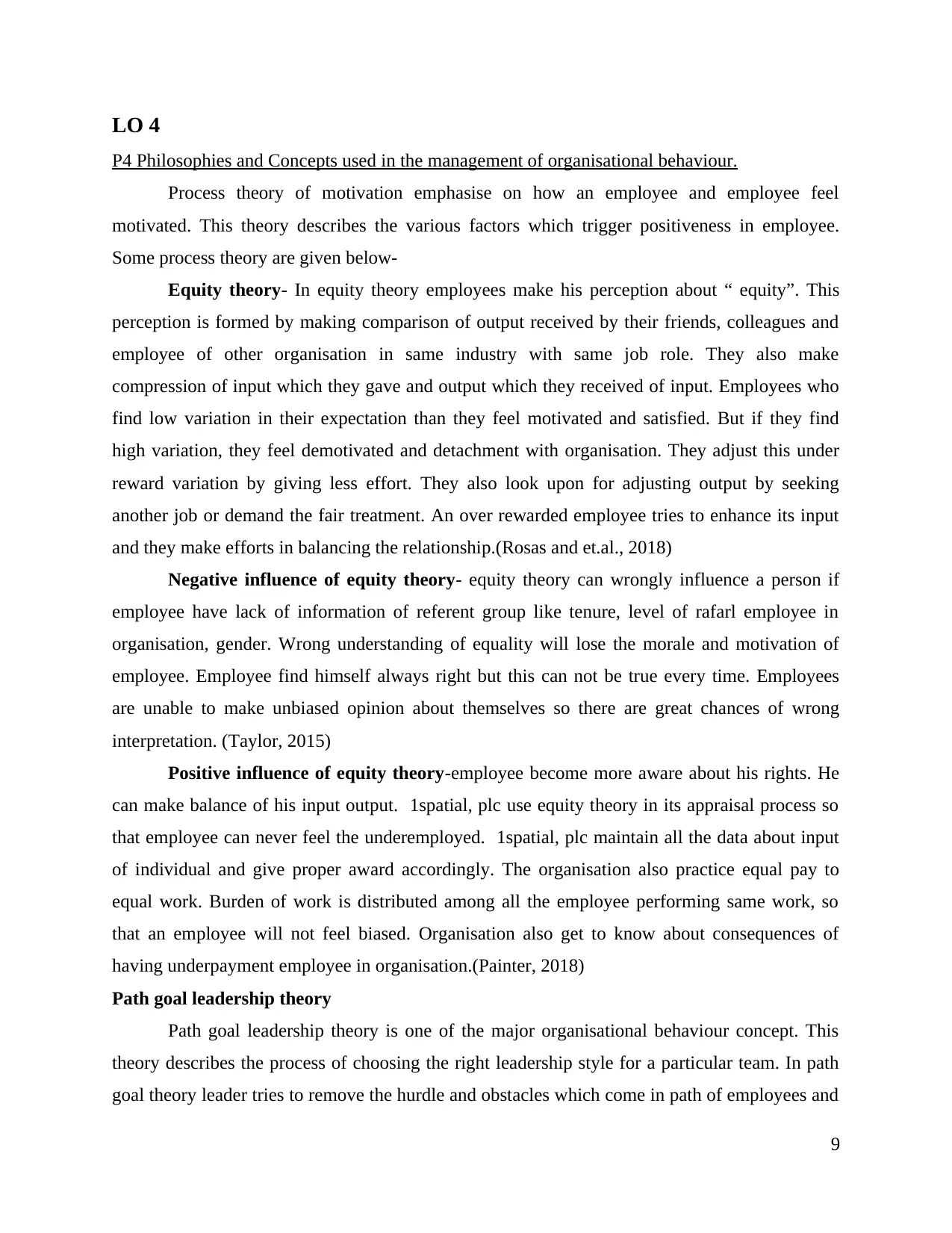
LO 4
P4 Philosophies and Concepts used in the management of organisational behaviour.
Process theory of motivation emphasise on how an employee and employee feel
motivated. This theory describes the various factors which trigger positiveness in employee.
Some process theory are given below-
Equity theory- In equity theory employees make his perception about “ equity”. This
perception is formed by making comparison of output received by their friends, colleagues and
employee of other organisation in same industry with same job role. They also make
compression of input which they gave and output which they received of input. Employees who
find low variation in their expectation than they feel motivated and satisfied. But if they find
high variation, they feel demotivated and detachment with organisation. They adjust this under
reward variation by giving less effort. They also look upon for adjusting output by seeking
another job or demand the fair treatment. An over rewarded employee tries to enhance its input
and they make efforts in balancing the relationship.(Rosas and et.al., 2018)
Negative influence of equity theory- equity theory can wrongly influence a person if
employee have lack of information of referent group like tenure, level of rafarl employee in
organisation, gender. Wrong understanding of equality will lose the morale and motivation of
employee. Employee find himself always right but this can not be true every time. Employees
are unable to make unbiased opinion about themselves so there are great chances of wrong
interpretation. (Taylor, 2015)
Positive influence of equity theory-employee become more aware about his rights. He
can make balance of his input output. 1spatial, plc use equity theory in its appraisal process so
that employee can never feel the underemployed. 1spatial, plc maintain all the data about input
of individual and give proper award accordingly. The organisation also practice equal pay to
equal work. Burden of work is distributed among all the employee performing same work, so
that an employee will not feel biased. Organisation also get to know about consequences of
having underpayment employee in organisation.(Painter, 2018)
Path goal leadership theory
Path goal leadership theory is one of the major organisational behaviour concept. This
theory describes the process of choosing the right leadership style for a particular team. In path
goal theory leader tries to remove the hurdle and obstacles which come in path of employees and
9
P4 Philosophies and Concepts used in the management of organisational behaviour.
Process theory of motivation emphasise on how an employee and employee feel
motivated. This theory describes the various factors which trigger positiveness in employee.
Some process theory are given below-
Equity theory- In equity theory employees make his perception about “ equity”. This
perception is formed by making comparison of output received by their friends, colleagues and
employee of other organisation in same industry with same job role. They also make
compression of input which they gave and output which they received of input. Employees who
find low variation in their expectation than they feel motivated and satisfied. But if they find
high variation, they feel demotivated and detachment with organisation. They adjust this under
reward variation by giving less effort. They also look upon for adjusting output by seeking
another job or demand the fair treatment. An over rewarded employee tries to enhance its input
and they make efforts in balancing the relationship.(Rosas and et.al., 2018)
Negative influence of equity theory- equity theory can wrongly influence a person if
employee have lack of information of referent group like tenure, level of rafarl employee in
organisation, gender. Wrong understanding of equality will lose the morale and motivation of
employee. Employee find himself always right but this can not be true every time. Employees
are unable to make unbiased opinion about themselves so there are great chances of wrong
interpretation. (Taylor, 2015)
Positive influence of equity theory-employee become more aware about his rights. He
can make balance of his input output. 1spatial, plc use equity theory in its appraisal process so
that employee can never feel the underemployed. 1spatial, plc maintain all the data about input
of individual and give proper award accordingly. The organisation also practice equal pay to
equal work. Burden of work is distributed among all the employee performing same work, so
that an employee will not feel biased. Organisation also get to know about consequences of
having underpayment employee in organisation.(Painter, 2018)
Path goal leadership theory
Path goal leadership theory is one of the major organisational behaviour concept. This
theory describes the process of choosing the right leadership style for a particular team. In path
goal theory leader tries to remove the hurdle and obstacles which come in path of employees and
9
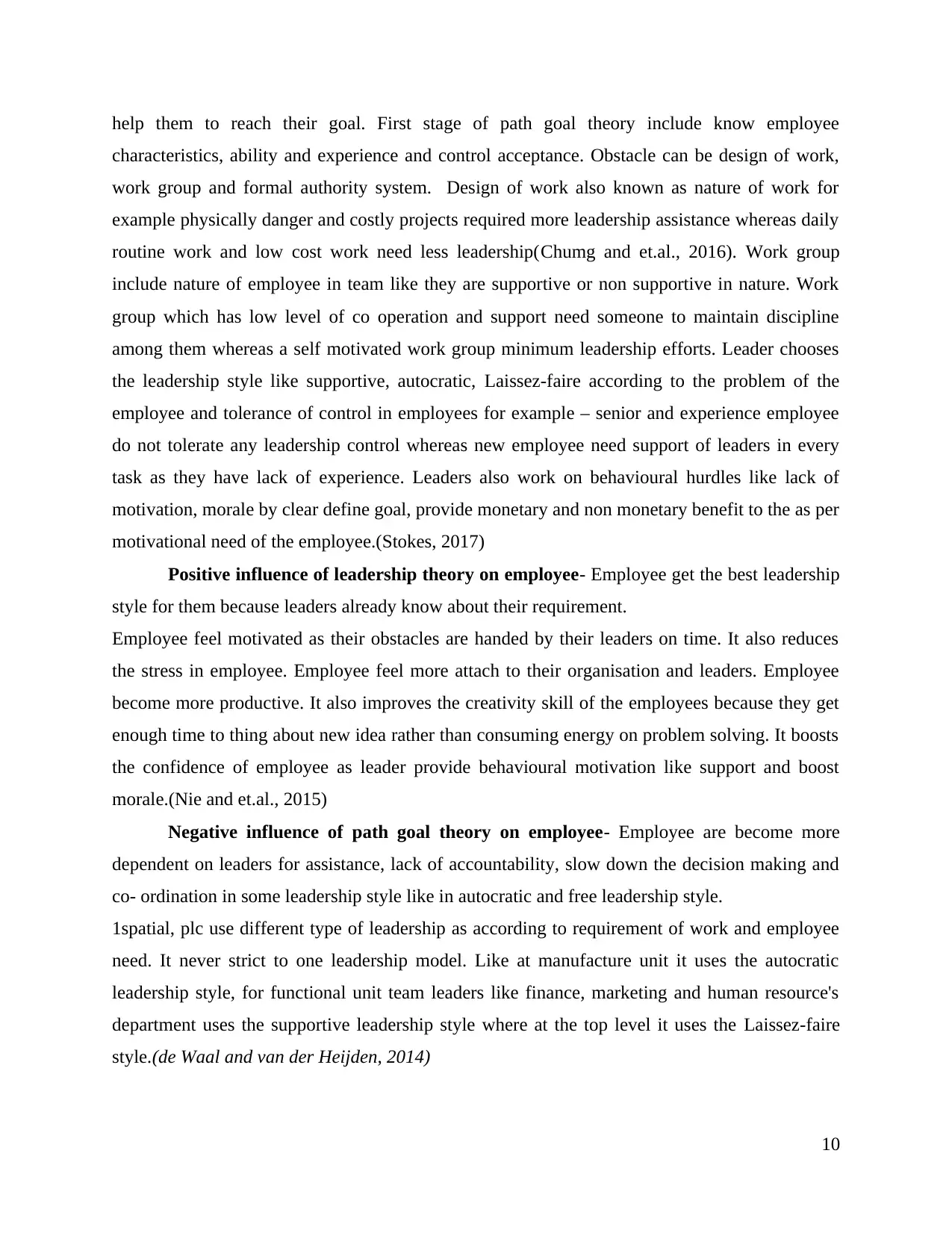
help them to reach their goal. First stage of path goal theory include know employee
characteristics, ability and experience and control acceptance. Obstacle can be design of work,
work group and formal authority system. Design of work also known as nature of work for
example physically danger and costly projects required more leadership assistance whereas daily
routine work and low cost work need less leadership(Chumg and et.al., 2016). Work group
include nature of employee in team like they are supportive or non supportive in nature. Work
group which has low level of co operation and support need someone to maintain discipline
among them whereas a self motivated work group minimum leadership efforts. Leader chooses
the leadership style like supportive, autocratic, Laissez-faire according to the problem of the
employee and tolerance of control in employees for example – senior and experience employee
do not tolerate any leadership control whereas new employee need support of leaders in every
task as they have lack of experience. Leaders also work on behavioural hurdles like lack of
motivation, morale by clear define goal, provide monetary and non monetary benefit to the as per
motivational need of the employee.(Stokes, 2017)
Positive influence of leadership theory on employee- Employee get the best leadership
style for them because leaders already know about their requirement.
Employee feel motivated as their obstacles are handed by their leaders on time. It also reduces
the stress in employee. Employee feel more attach to their organisation and leaders. Employee
become more productive. It also improves the creativity skill of the employees because they get
enough time to thing about new idea rather than consuming energy on problem solving. It boosts
the confidence of employee as leader provide behavioural motivation like support and boost
morale.(Nie and et.al., 2015)
Negative influence of path goal theory on employee- Employee are become more
dependent on leaders for assistance, lack of accountability, slow down the decision making and
co- ordination in some leadership style like in autocratic and free leadership style.
1spatial, plc use different type of leadership as according to requirement of work and employee
need. It never strict to one leadership model. Like at manufacture unit it uses the autocratic
leadership style, for functional unit team leaders like finance, marketing and human resource's
department uses the supportive leadership style where at the top level it uses the Laissez-faire
style.(de Waal and van der Heijden, 2014)
10
characteristics, ability and experience and control acceptance. Obstacle can be design of work,
work group and formal authority system. Design of work also known as nature of work for
example physically danger and costly projects required more leadership assistance whereas daily
routine work and low cost work need less leadership(Chumg and et.al., 2016). Work group
include nature of employee in team like they are supportive or non supportive in nature. Work
group which has low level of co operation and support need someone to maintain discipline
among them whereas a self motivated work group minimum leadership efforts. Leader chooses
the leadership style like supportive, autocratic, Laissez-faire according to the problem of the
employee and tolerance of control in employees for example – senior and experience employee
do not tolerate any leadership control whereas new employee need support of leaders in every
task as they have lack of experience. Leaders also work on behavioural hurdles like lack of
motivation, morale by clear define goal, provide monetary and non monetary benefit to the as per
motivational need of the employee.(Stokes, 2017)
Positive influence of leadership theory on employee- Employee get the best leadership
style for them because leaders already know about their requirement.
Employee feel motivated as their obstacles are handed by their leaders on time. It also reduces
the stress in employee. Employee feel more attach to their organisation and leaders. Employee
become more productive. It also improves the creativity skill of the employees because they get
enough time to thing about new idea rather than consuming energy on problem solving. It boosts
the confidence of employee as leader provide behavioural motivation like support and boost
morale.(Nie and et.al., 2015)
Negative influence of path goal theory on employee- Employee are become more
dependent on leaders for assistance, lack of accountability, slow down the decision making and
co- ordination in some leadership style like in autocratic and free leadership style.
1spatial, plc use different type of leadership as according to requirement of work and employee
need. It never strict to one leadership model. Like at manufacture unit it uses the autocratic
leadership style, for functional unit team leaders like finance, marketing and human resource's
department uses the supportive leadership style where at the top level it uses the Laissez-faire
style.(de Waal and van der Heijden, 2014)
10
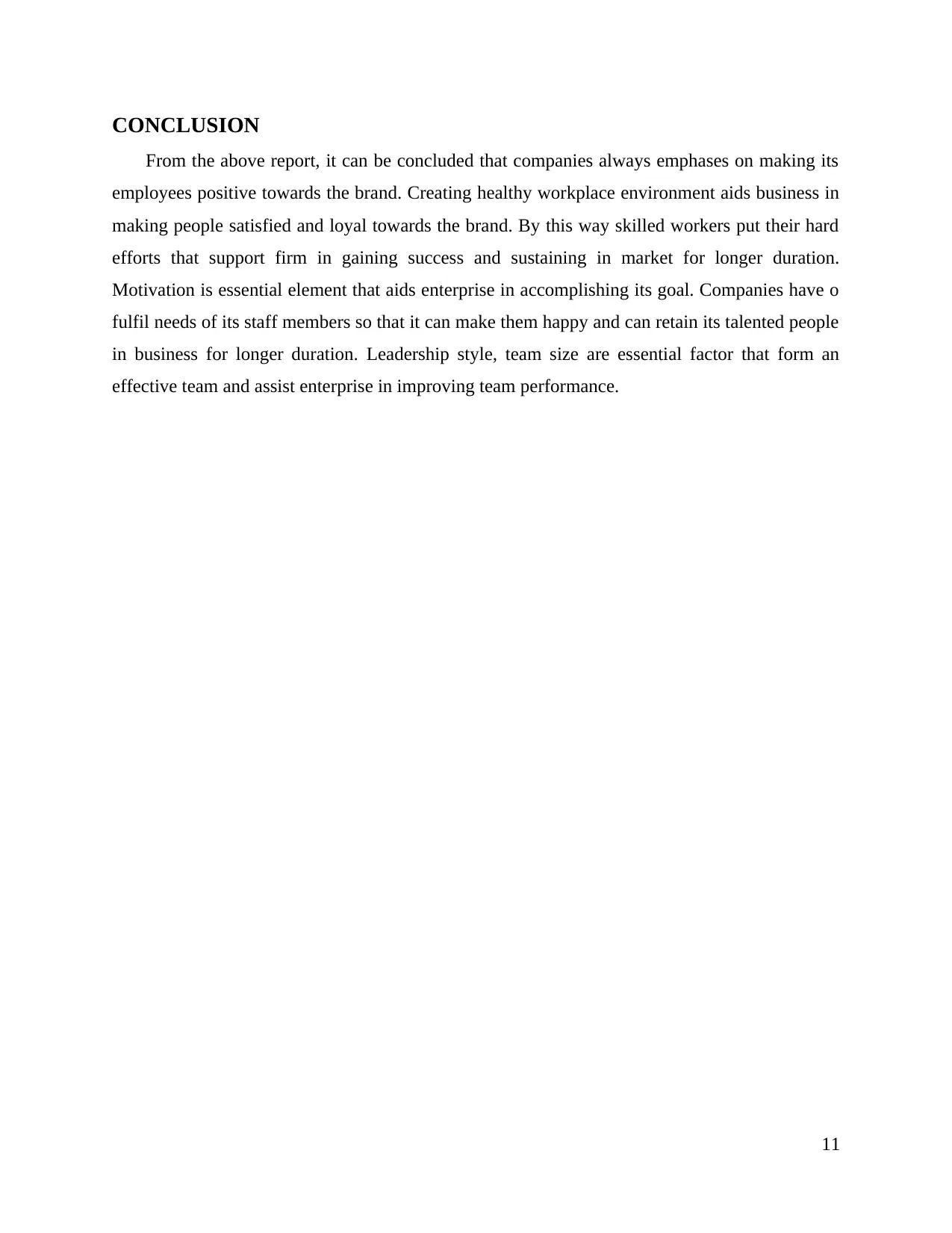
CONCLUSION
From the above report, it can be concluded that companies always emphases on making its
employees positive towards the brand. Creating healthy workplace environment aids business in
making people satisfied and loyal towards the brand. By this way skilled workers put their hard
efforts that support firm in gaining success and sustaining in market for longer duration.
Motivation is essential element that aids enterprise in accomplishing its goal. Companies have o
fulfil needs of its staff members so that it can make them happy and can retain its talented people
in business for longer duration. Leadership style, team size are essential factor that form an
effective team and assist enterprise in improving team performance.
11
From the above report, it can be concluded that companies always emphases on making its
employees positive towards the brand. Creating healthy workplace environment aids business in
making people satisfied and loyal towards the brand. By this way skilled workers put their hard
efforts that support firm in gaining success and sustaining in market for longer duration.
Motivation is essential element that aids enterprise in accomplishing its goal. Companies have o
fulfil needs of its staff members so that it can make them happy and can retain its talented people
in business for longer duration. Leadership style, team size are essential factor that form an
effective team and assist enterprise in improving team performance.
11
Paraphrase This Document
Need a fresh take? Get an instant paraphrase of this document with our AI Paraphraser

REFERENCES
Books and Journals
Chumg, H. F. and et.al., 2016. Factors affecting employees' knowledge-sharing behaviour in the
virtual organisation from the perspectives of well-being and organisational behaviour.
Computers in Human Behavior. 64. pp.432-448.
de Waal, A. A. and van der Heijden, B. I., 2014, June. The Role of Performance Management in
the High Performance Organisation. In PMA 2014 Conference on Performance
Management: Designing the High-Performance Organization. University of Aarhus.
Georgalis, J. and et.al., 2015. Change process characteristics and resistance to organisational
change: The role of employee perceptions of justice. Australian Journal of Management.
40(1). pp.89-113.
Ibrahim, M. S. and et.al., 2018. DESCRIPTIVE ANALYSIS OF QUALITY FEATURES IN
THE NON-PROFIT ORGANISATION (NPO) WEB SITE. Asian Journal of Applied
Communication Volume. 7(1).
Koganti, N. and et.al., 2015. Effect of granule organisation on the behaviour of starches in the
NMMO (N-methyl morpholine N-oxide) solvent system. Carbohydrate polymers. 116.
pp.103-110.
Nie, Y. and et.al., 2015. The importance of autonomy support and the mediating role of work
motivation for well‐being: Testing self‐determination theory in a Chinese work
organisation. International Journal of Psychology. 50(4). pp.245-255.
Painter, K. J., 2018. Mathematical models for chemotaxis and their applications in self-
organisation phenomena. Journal of theoretical biology.
Pereira, V., 2017. National Business Systems in Asian Countries: Impact on Human Resource
Management, Employment Relations Practices and Organisation Behaviour. Emerald
Publishing.
Rosas, F. and et.al., 2018. An information-theoretic approach to self-organisation: Emergence of
complex interdependencies in coupled dynamical systems. Entropy. 20(10). pp.793.
Salminen, H., Vanhala, M. and Heilmann, P., 2017. Work-related attitudes as antecedents of
perceived individual-, unit-and organisation-level performance. International Journal of
Organizational Analysis. 25(4). pp.577-595.
12
Books and Journals
Chumg, H. F. and et.al., 2016. Factors affecting employees' knowledge-sharing behaviour in the
virtual organisation from the perspectives of well-being and organisational behaviour.
Computers in Human Behavior. 64. pp.432-448.
de Waal, A. A. and van der Heijden, B. I., 2014, June. The Role of Performance Management in
the High Performance Organisation. In PMA 2014 Conference on Performance
Management: Designing the High-Performance Organization. University of Aarhus.
Georgalis, J. and et.al., 2015. Change process characteristics and resistance to organisational
change: The role of employee perceptions of justice. Australian Journal of Management.
40(1). pp.89-113.
Ibrahim, M. S. and et.al., 2018. DESCRIPTIVE ANALYSIS OF QUALITY FEATURES IN
THE NON-PROFIT ORGANISATION (NPO) WEB SITE. Asian Journal of Applied
Communication Volume. 7(1).
Koganti, N. and et.al., 2015. Effect of granule organisation on the behaviour of starches in the
NMMO (N-methyl morpholine N-oxide) solvent system. Carbohydrate polymers. 116.
pp.103-110.
Nie, Y. and et.al., 2015. The importance of autonomy support and the mediating role of work
motivation for well‐being: Testing self‐determination theory in a Chinese work
organisation. International Journal of Psychology. 50(4). pp.245-255.
Painter, K. J., 2018. Mathematical models for chemotaxis and their applications in self-
organisation phenomena. Journal of theoretical biology.
Pereira, V., 2017. National Business Systems in Asian Countries: Impact on Human Resource
Management, Employment Relations Practices and Organisation Behaviour. Emerald
Publishing.
Rosas, F. and et.al., 2018. An information-theoretic approach to self-organisation: Emergence of
complex interdependencies in coupled dynamical systems. Entropy. 20(10). pp.793.
Salminen, H., Vanhala, M. and Heilmann, P., 2017. Work-related attitudes as antecedents of
perceived individual-, unit-and organisation-level performance. International Journal of
Organizational Analysis. 25(4). pp.577-595.
12
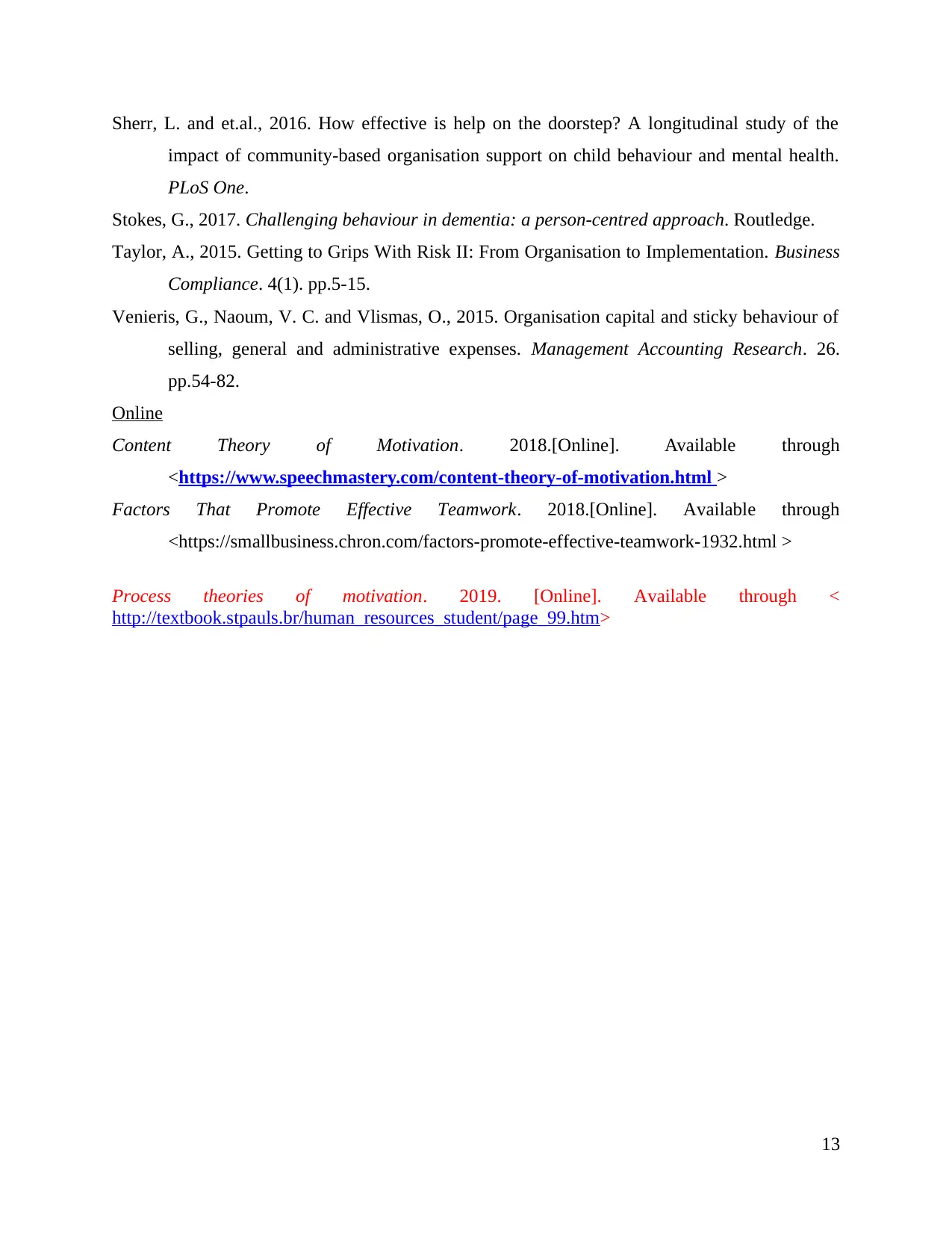
Sherr, L. and et.al., 2016. How effective is help on the doorstep? A longitudinal study of the
impact of community-based organisation support on child behaviour and mental health.
PLoS One.
Stokes, G., 2017. Challenging behaviour in dementia: a person-centred approach. Routledge.
Taylor, A., 2015. Getting to Grips With Risk II: From Organisation to Implementation. Business
Compliance. 4(1). pp.5-15.
Venieris, G., Naoum, V. C. and Vlismas, O., 2015. Organisation capital and sticky behaviour of
selling, general and administrative expenses. Management Accounting Research. 26.
pp.54-82.
Online
Content Theory of Motivation. 2018.[Online]. Available through
<https://www.speechmastery.com/content-theory-of-motivation.html >
Factors That Promote Effective Teamwork. 2018.[Online]. Available through
<https://smallbusiness.chron.com/factors-promote-effective-teamwork-1932.html >
Process theories of motivation. 2019. [Online]. Available through <
http://textbook.stpauls.br/human_resources_student/page_99.htm>
13
impact of community-based organisation support on child behaviour and mental health.
PLoS One.
Stokes, G., 2017. Challenging behaviour in dementia: a person-centred approach. Routledge.
Taylor, A., 2015. Getting to Grips With Risk II: From Organisation to Implementation. Business
Compliance. 4(1). pp.5-15.
Venieris, G., Naoum, V. C. and Vlismas, O., 2015. Organisation capital and sticky behaviour of
selling, general and administrative expenses. Management Accounting Research. 26.
pp.54-82.
Online
Content Theory of Motivation. 2018.[Online]. Available through
<https://www.speechmastery.com/content-theory-of-motivation.html >
Factors That Promote Effective Teamwork. 2018.[Online]. Available through
<https://smallbusiness.chron.com/factors-promote-effective-teamwork-1932.html >
Process theories of motivation. 2019. [Online]. Available through <
http://textbook.stpauls.br/human_resources_student/page_99.htm>
13
1 out of 15
Related Documents
Your All-in-One AI-Powered Toolkit for Academic Success.
+13062052269
info@desklib.com
Available 24*7 on WhatsApp / Email
![[object Object]](/_next/static/media/star-bottom.7253800d.svg)
Unlock your academic potential
© 2024 | Zucol Services PVT LTD | All rights reserved.





